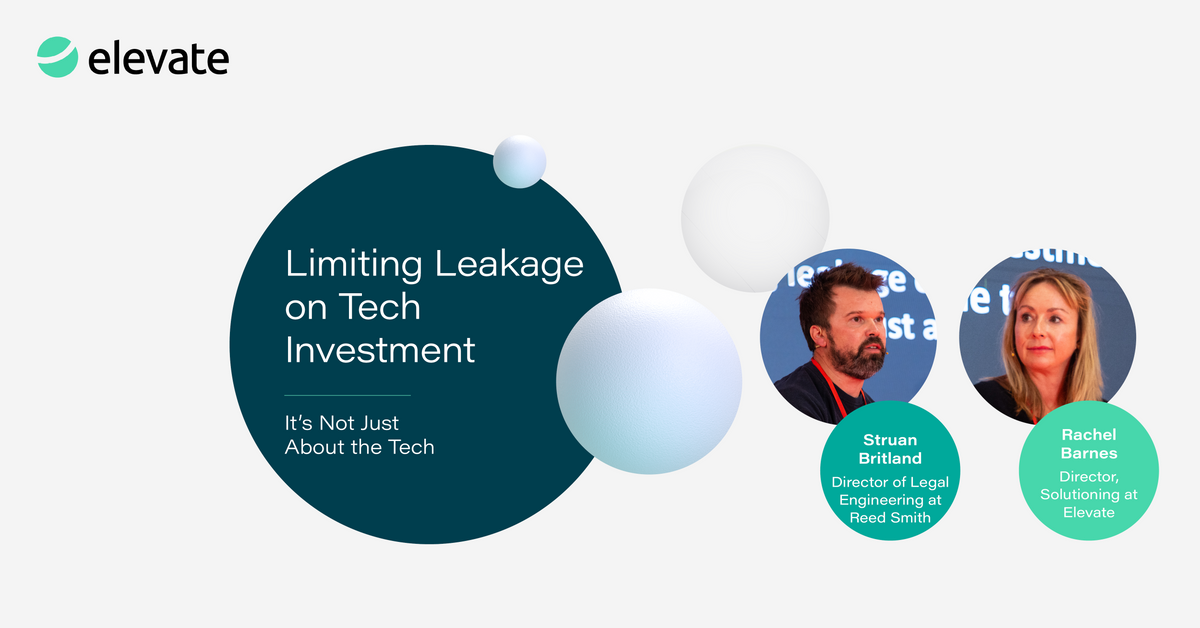Maximise ROI by Limiting Leakage in Tech Investments with These Three Steps
October 28, 2022
Consulting event legal geek law company technology investment ROI
Leakage is the bane of any investment in technology, and reducing it directly improves ROI of adopting new tech and the changes it enables. With that in mind, last month’s Legal Geek Conference included an interactive session highlighting the benefits of law firm and technology provider collaboration as a way to minimise leakage in technology investments.
The session featured Rachel Barnes, Director of Consulting at Elevate, and Reed Smith’s Director of Legal Engineering, Struan Britland. (If you missed it, you can view it on demand here.) At the outset, they discussed how too often, law organisations think that innovation means new technology. This mindset can drive purchasing decisions that are premature or not well thought out. Leakage — many times, significant — is almost inevitable.
Instead, Rachel and Struan advised, law departments and firms should “make haste slowly” and focus on three key steps:
First, identify “operationalisable” activities — work that is easily described in words and that follows a set process that does not require legal judgments that affect the rest of the process. Document in detail how the work is done, by whom, and in what sequence. As part of this exercise, review the process to identify and eliminate inefficiencies. This requires asking a lot of “why” questions–why is this step necessary (e.g., is there a simpler, faster way to achieve the goal?), why is a particular person performing a certain task (i.e., is someone else better situated to do it?), and why are the steps in this specific order (e.g., are there efficiencies from reordering certain tasks?).
Next, identify areas suitable for leveraging technology. The technology doesn’t have to be “new, shiny, and expensive”. Start with your existing tech stack and explore its untapped potential. For example, O365 has a host of features that many — sometimes, most — users are unaware even exist. Sometimes, though, what you have is insufficient or not well-suited for a certain workflow. Having already documented and optimised the workflow in the step described in the preceding paragraph, you will have laid the groundwork for identifying suitable new tools, implementing them, and maximising their use.
Third, systematically measure to assess your ROI. The ‘I’ is more than money; it includes time spent on documenting and refining processes, preparing for deployment, and work required to drive adoption. The “R” comes in many forms — the most obvious ones are cost- and time-savings, reduced staffing requirements, faster and better work product, and higher satisfaction of the relevant stakeholders. But these projects also provide other important benefits that take longer and are more difficult to perceive: the evolution of your firm’s capabilities, improvements in its culture, and clients’ perceptions of what your firm can do and how innovative it is. The more systematic you are in measuring investment and results, the clearer and more accurate picture you will have of ROI.
These three steps help ensure that investments in technology are sensible and achieve (and even exceed) your objective with maximum return. The key is to proceed deliberately: document and optimise the process at issue, investigate technology options, and assess ROI. That approach will limit leakage, with all the benefits doing so brings.
Back to Expertise

 Frazer Baron
Frazer Baron Rachel Barnes
Rachel Barnes